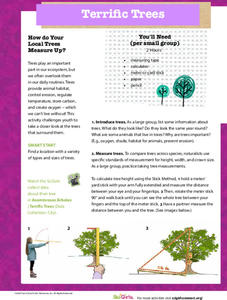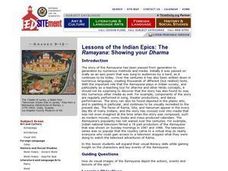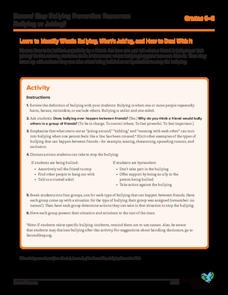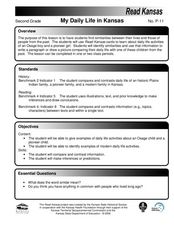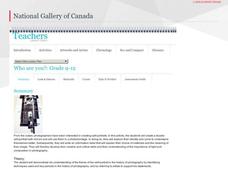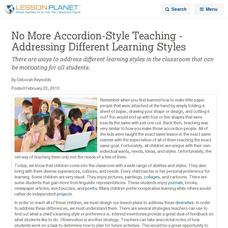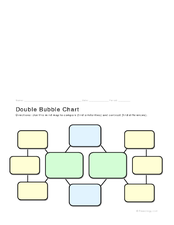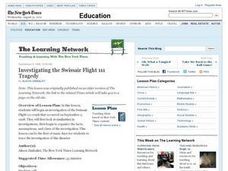Balanced Assessment
Transformation I
Rewriting expressions in different forms is an essential algebra skill. Support the development of this skill by using a task that asks scholars to begin with a linear, quadratic, and rational expression and then manipulate...
PBS
Terrific Trees
Engage in a shady activity to practice measurement techniques. Classes venture outside to collect measurements of various trees, using different strategies to measure the height, trunk circumference, width, and crown size. Then they...
Curated OER
The Ramayana: Showing your Dharma
Young scholars identify characters and events from the Ramayana. They discuss ways in whcih the images convey non-verbal information and messages. They discuss similarities and differences in the visual and verbal tellings of the Ramayana.
Committee for Children
Learn to Identify What’s Bullying, What’s Joking, and How to Deal With It
A quick lesson takes a look at the differences between bullying and joking. Through whole-class discussion, scholars identify between the two behaviors and brainstorm actions to take to cease bullying behavior. Small groups share with...
Curated OER
My Daily Life in Kansas
Second graders use 'Read Kansas' cards to learn about the daily life activities of an Osage boy and a pioneer girl. In this similarities and differences lesson, 2nd graders write a paragraph and draw a picture comparing...
Curated OER
GOOD APPLES
Students consider society. In this respect lesson, students discover the importance of recognizing the positive aspects of people having similarities and differences. They discuss this concept as a class and participate in an activity...
Curated OER
Take A Seat!
Take a different look at cultural differences in this presentation - study chairs of different cultures! Learners look at chairs that have been used by African Chiefs, British Royalty, and everyday people in schools. They discuss the...
Curated OER
Similar/Different: Nervous System
In this nervous system worksheet, students identify 2 ways that a computer and brain, a telephone wire and the spinal cord and a camera and an eye are similar and different.
Curated OER
Who Are You?
Students complete self projects such as a collage, an acrostic poem, a mural, and more, to show their similarities and differences. In this similarities and differences lesson plan, students can do these projects individually or in groups.
Curated OER
United States & Canada: How Are We The Same? How Are We Different?
Learners compare and contrast similarities and differences between Canada and the US. In this geography lesson, students read various articles and identify similarities and differences in economies, cultures, geography, climate,...
Curated OER
Identifying Our Similarities, Despite Our Differences
Students discuss similarities and differences among the members of their class. They read and discuss several books about children with disabilities and then draw and/or write about someone they can think of who has a disability and...
Curated OER
Same and Different
Students explore similarities and differences. They name ways they are alike and different from their peers.
Curated OER
What's Alike, What's Different Worksheet
In this occupations worksheet, students create a spreadsheet by answering the 3 short answer questions in order to find similarities and differences among occupations.
Curated OER
The Differences Among Us
Students compare cultures. For this writing skills lesson, students collaborate to chart the tradition and cultural beliefs of their classmates. Students use their finding to write comparative essays regarding the similarities and...
Curated OER
Character Comparison Worksheet
In this characters worksheet, students choose 2 characters to analyze, list the characters similarities and differences in the boxes provided.
Curated OER
No More Accordion-Style Teaching - Addressing Different Learning Styles
There are ways to address different learning styles in the classroom that can be motivating for all students.
Curated OER
Recognizing Our Similarities and Differences: King Day
Students discover diversity. In this service learning lesson, students read The Sneeches and discuss the benefits of being respectful toward one another.
Curated OER
Cultural Differences and Similarities
In this ESL activity activity, students examine cultural differences and similarities as they record their answers concerning weather, religion, sport, traditions, food, and education.
Curated OER
Getting to Know You
Students interview each other to find similarities and differences with their partner. They create a Venn diagram that displays their findings and then using hula hoops as a large scale model present their Venn diagram to the class as a...
Curated OER
Double Bubble Chart
In this graphic organizer worksheet, students fill in the graphic organizer with the similarities and differences of 2 items. Students complete 10 sections.
Curated OER
Alike and Different
Second graders listen to a book about how farms feed the world. They discuss elements of rural life. They listen to a story about the suburbs and discuss elements specific to a suburban community. They listen to a story about city...
Curated OER
Shades of Meaning
Examine and distinguish between words that have similar definitions but different connotations. Middle schoolers define connotation and denotation and participate in a "shades of meaning" contest in small groups. Groups use the...
Curated OER
What is Different?
In this visual interpretation worksheet, students look at the top and bottom pictures. Students find one thing that is different in the bottom picture and circle that item.
Curated OER
Investigating the Swissair Flight 111 Tragedy
Middle schoolers read two articles about the same event: "Plane from J.F.K Crashes off Canada" from the New York Times and "No Survivors from Crash of Swissair Jetliner Off Nova Scotia" from the Associated Press. They then compare the...

